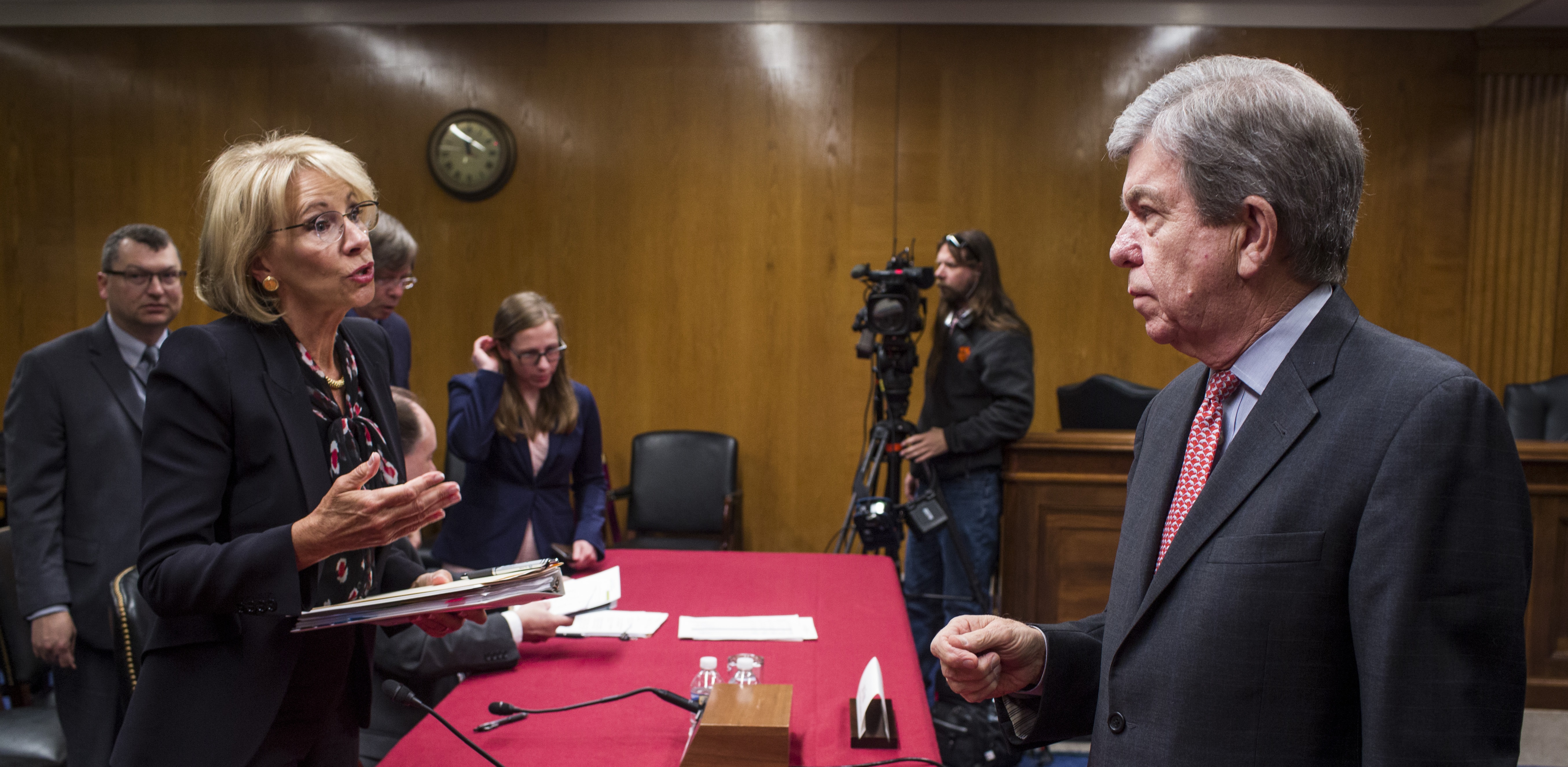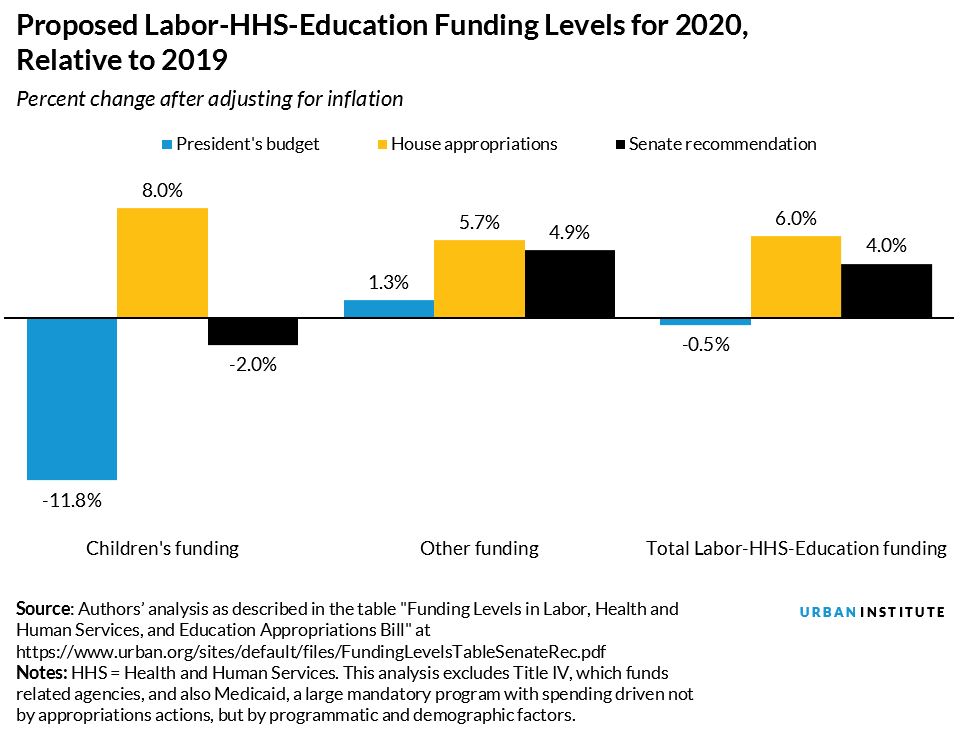
The Labor, Health and Human Services (HHS), and Education appropriations bill sets federal funding levels for important programs supporting our nation’s children, including Head Start, child care, Education for the Disadvantaged (Title I), and Special Education. Where these investments end up has consequences for building the capacity of tomorrow’s workforce and economy.
Despite stalled budget negotiations, Senator Roy Blunt (R-MO), chair of the Senate appropriations subcommittee overseeing these agencies, has released a draft Senate bill with recommended fiscal year 2020 funding for programs within the Departments of Labor, HHS, and Education.
The Senate recommendation would decrease fiscal year 2020 funding for children by 2 percent relative to 2019. At the same time, the Senate recommends a 4 percent increase in overall funding levels in the bill. (Increases and decreases are measured relative to 2019 levels, adjusted for inflation.)
Comparing the Senate recommendation with the House bill and the president’s budget
In contrast, the House passed a Labor-HHS-Education appropriations bill with an 8 percent increase in children’s programs relative to 2019, as detailed in an earlier analysis. The Senate recommendation rejects most of these increases, but it also rejects many of the reductions proposed in the president’s budget, including an overall 12 percent decrease in children’s programs covered by the fiscal year 2020 Labor-HHS-Education bill (see figure below).

Overall, Chairman Blunt recommends a 4 percent increase in Labor-HHS-Education funding, somewhat lower than the 6 percent increase in the House bill. The 4 percent increase above 2019 levels is in line with the caps on nondefense discretionary programs assumed in the budget deal agreed to in late July.
Although the overall funding levels are guided by the budget deal, the House and Senate can target spending increases toward children’s programs or nonchildren’s programs. The House provides children’s programs with a disproportionate share of increases. The Senate does not.
Under the draft bill to be considered in the Senate, most increases are concentrated in nonchildren’s programs, including a $3 billion (8 percent) increase in funding for the National Institutes of Health. Most children’s programs receive flat funding in the draft bill, which means their appropriations actually fall 2 percent below 2019 levels after adjusting for inflation.
A review of individual children’s programs, as shown in this table (PDF), highlights differences between the Senate recommendation, the House bill, and the president’s budget request:
- The Senate draft bill follows the president’s budget in recommending flat funding—or a 2 percent cut after adjusting for inflation—for the Child Care and Development Fund and a smaller-than-inflation increase for Head Start (a 1 percent cut in real terms). The House bill, however, increases early childhood spending, with increases of 46 percent for the Child Care Development fund and 13 percent for Head Start.
- Similarly, the draft Senate bill recommends flat funding (or a 2 percent cut in real terms) for Unaccompanied Alien Children, a program that helps house and care for children in immigration custody. In contrast, the House bill increases spending for this program by 36 percent over 2019 levels.
- Chairman Blunt’s Senate bill recommends maintaining support for several programs that were cut or eliminated under the administration’s proposal, including the Low Income Home Energy Assistance Program (LIHEAP), the Social Services Block Grant Program, Job Corps, and 21st Century Community Learning Centers, which are funded as part of School Improvement programs.
Where will Congress land on funding levels for children?
Both the Senate and House will have more opportunities to weigh in on funding levels before the Labor-HHS-Education appropriations bill becomes law. The next steps are for the bill to be marked up and reported out by the subcommittee and the Senate Committee on Appropriations and then voted on by the full Senate. Senators may make amendments during that process. Then, a House-Senate conference will attempt to work out the differences between the House and Senate and send a bill to the president to be signed.
Because this was not accomplished by September 30, the Departments of Labor, HHS, and Education and other government agencies are operating under a continuing resolution that maintains current funding levels through November 21. However, negotiations continue to face challenges which have already delayed progress on Labor-HHS-Education appropriations, including debates unrelated to funding, such as those over abortion and the border wall.
Funding for children’s programs is unlikely to attract substantial attention in this environment. This and other Kids’ Share analyses seek to elevate the debate on children’s issues so that decisions about children’s programs can be informed by evidence.
Tune in and subscribe today.
The Urban Institute podcast, Evidence in Action, inspires changemakers to lead with evidence and act with equity. Cohosted by Urban President Sarah Rosen Wartell and Executive Vice President Kimberlyn Leary, every episode features in-depth discussions with experts and leaders on topics ranging from how to advance equity, to designing innovative solutions that achieve community impact, to what it means to practice evidence-based leadership.